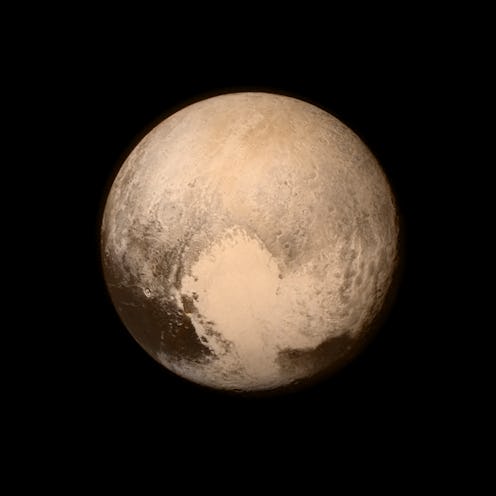News
NASA's Family Photo Collection Is Finally Complete
No family photo turns out especially well, does it? Either someone is sneezing, the adults are in a big fight, or the photo is taken right in the middle of awkward tween years. When it comes to Solar System family photography, Pluto is the rejected stepchild who wasn't even asked to be in the picture. That's all changed now that NASA released its first close-up photo of Pluto.
In a particularly controversial move, Pluto lost its planet status in 2006 and was reclassified as a dwarf planet. So in 2010, when the MESSENGER spacecraft took a mosaic of 34 photos from outside the Solar System that included Mercury, Earth, Mars, Venus, Jupiter, Saturn, Uranus, and Neptune, no one seemed to mind that Pluto was missing from the "family portrait."
However, Pluto can feel a little more included now that NASA’s New Horizons spacecraft sent back the first close-up photo of the dwarf planet's surface. The craft launched from Cape Canaveral in 2006, and has been sending back photos of its journey from Earth to the icy Pluto. Via Instagram on Tuesday morning, NASA released the most detailed photo of Pluto that the space community has ever seen. New Horizons caught the image on Monday afternoon, about 16 hours before the moment of closest approach to the dwarf planet.
This photo completes NASA's collection of close-up pictures of the planets. Given that the dwarf planet is millions of miles from the Earth, it makes sense that it took so long to get a decent photo of Pluto. New Horizon's journey took more than nine years, according to Wired. At 7:49:58 a.m. EDT Tuesday, it passed Pluto at 7,750 miles. It had traveled 3,463 days and 2.97 billion miles.
Unfortunately, Pluto still technically isn't in the family photo. 2010 wasn't even the first time that NASA has seemed to forget about the rejected Pluto. In 1990, Voyager 1 took the first family portrait from outside the solar system. The mosaic, consisting of 60 frames, included Venus, Earth, Jupiter, Saturn, Uranus, and Neptune. Pluto was notably missing, even though the astronomical community considered Pluto a planet at that point.
According to Time, NASA social media manager John Yembrick said that they "made an editorial decision to give the world a sneak peek of the image on Instagram.” Users bestowed 142,000 likes upon the photo within its first three hours online. Suddenly, Pluto is a lot more popular than it was in 2006.
Hopefully, the popularity boost will make Pluto supporters feel a little better about its demotion. Some people have even taken it upon themselves to make their own family portraits that are a little more inclusive.
Images: Getty Images; NASA.gov
